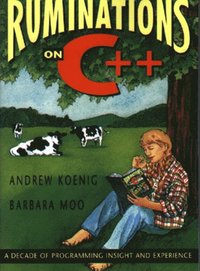
- Format
- Häftad (Paperback)
- Språk
- Engelska
- Antal sidor
- 400
- Utgivningsdatum
- 1996-08-01
- Upplaga
- 1
- Förlag
- Addison Wesley
- Medarbetare
- Moo, Barbara E.
- Illustrationer
- Illustrations
- Dimensioner
- 235 x 160 x 23 mm
- Vikt
- Antal komponenter
- 1
- ISBN
- 9780201423396
- 580 g
Kundrecensioner
Fler böcker av Andrew Koenig
-
Accelerated C++: Practical Programming by Example
Andrew Koenig, Barbara E Moo
This is a first-rate introductory book that takes a practical approach to solving problems using C++. It covers a much wider scope of C++ programming than other introductory books I've seen, and in a surprisingly compact format. --Dag Brck, foundi...
Övrig information
Andrew Koenig is a member of the Large-Scale Programming Research Department at AT&T's Shannon Laboratory, and the Project Editor of the C++ standards committee. A programmer for more than 30 years, 15 of them in C++, he has published more than 150 articles about C++, and speaks on the topic worldwide. Barbara E. Moo is an independent consultant with 20 years' experience in the software field. During her nearly 15 years at AT&T, she worked on one of the first commercial products ever written in C++, managed the company's first C++ compiler project, and directed the development of AT&T's award-winning WorldNet Internet service business. 0
Innehållsförteckning
Preface.
Prelude.
I. MOTIVATION.
1. Why I Use C++.The Problem.History and Context.Automatic Software Distribution.Enter C++.Recycled Software.Postscript.2. Why I Work on C++.
The Success of Small Projects.Abstraction.Machines Should Work for People.3. Living in the Real World.
II. CLASSES aND INHERITANCE.
4. Checklist for Class Authors.5. Surrogate Classes.
The Problem.The Classical Solution.Virtual Copy Functions.Defining a Surrogate Class.Summary.6. Handles: Part 1.
The Problem.A Simple Class.Attaching a Handle.Getting at the Object.Simple Implementation.Use-Counted Handles.Copy on Write.Discussion.7. Handles: Part 2.
Review.Separating the use Count.Abstraction of use Counts.Access Functions and Copy on Write.Discussion.8. An Object-Oriented Program.
The Problem.An Object-Oriented Solution.Handle Classes.Extension 1: New Operations.Extension 2: New Node Types.Reflections.9. Analysis of a Classroom Exercise: Part 1.
The Problem.Designing the Interface.A Few Loose Ends.Testing the Interface.Strategy.Tactics.Combining Pictures.Conclusion.10. Analysis of a Classroom Exercise: Part 2.
Strategy.Exploiting the Structure.Conclusion.11. When not to use Virtual Functions.
The Case For.The Case Against.Destructors are Special.Summary.
III. TEMPLATES.
12. Designing a Container Class.What Does it Contain?What Does Copying the Container Mean?How Do You Get at Container Elements?How Do You Distinguish Reading from Writing?How Do You Handle Container Growth?What Operations Does the Container Provide?What Do You Assume about the Container Element Type?Containers and Inheritance.Designing an Arraylike Class.13. Accessing Container Elements.
Imitating a Pointer.Getting at the Data.Remaining Problems.Pointer to Const Array.Useful Additions.
<...
